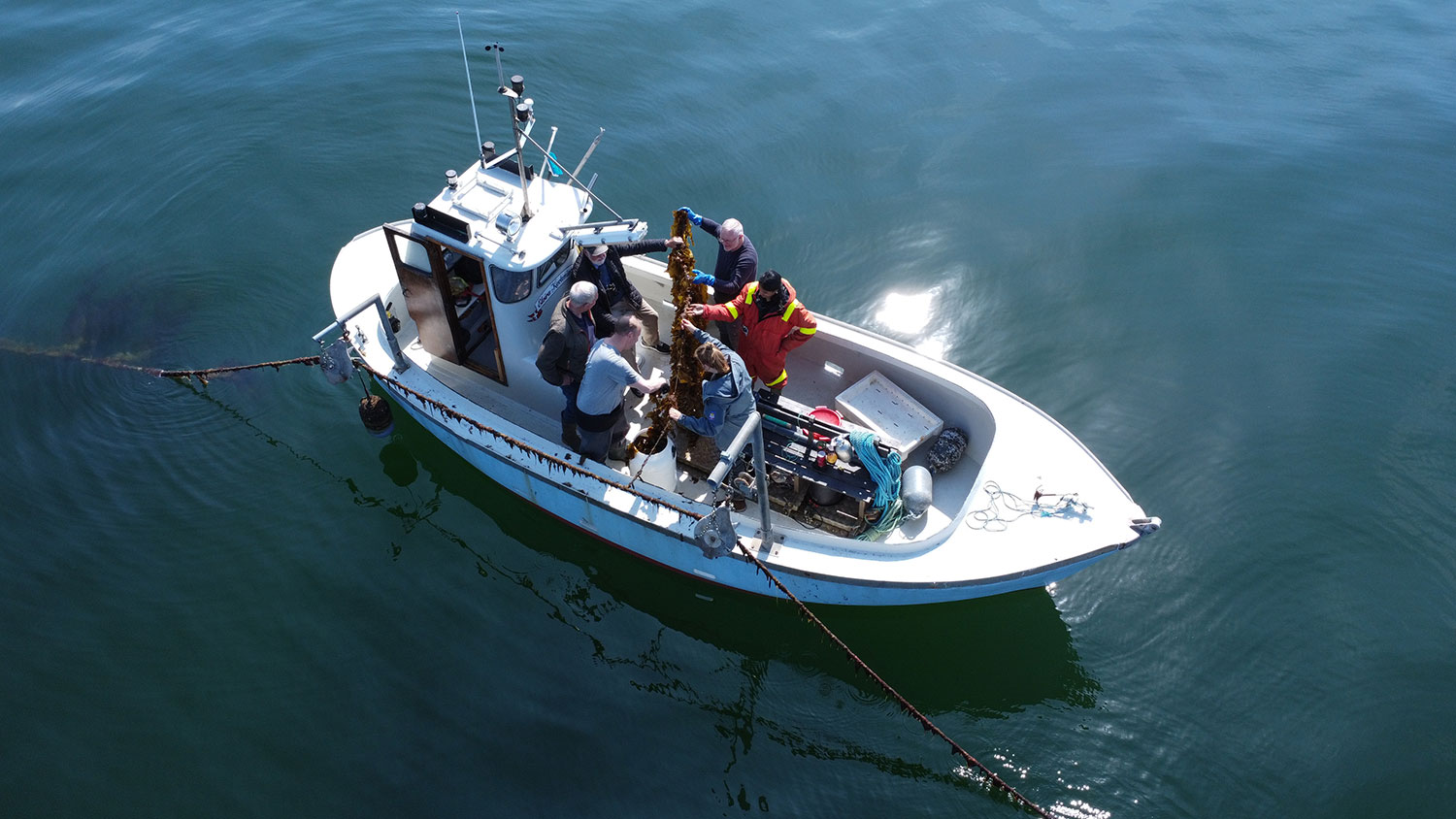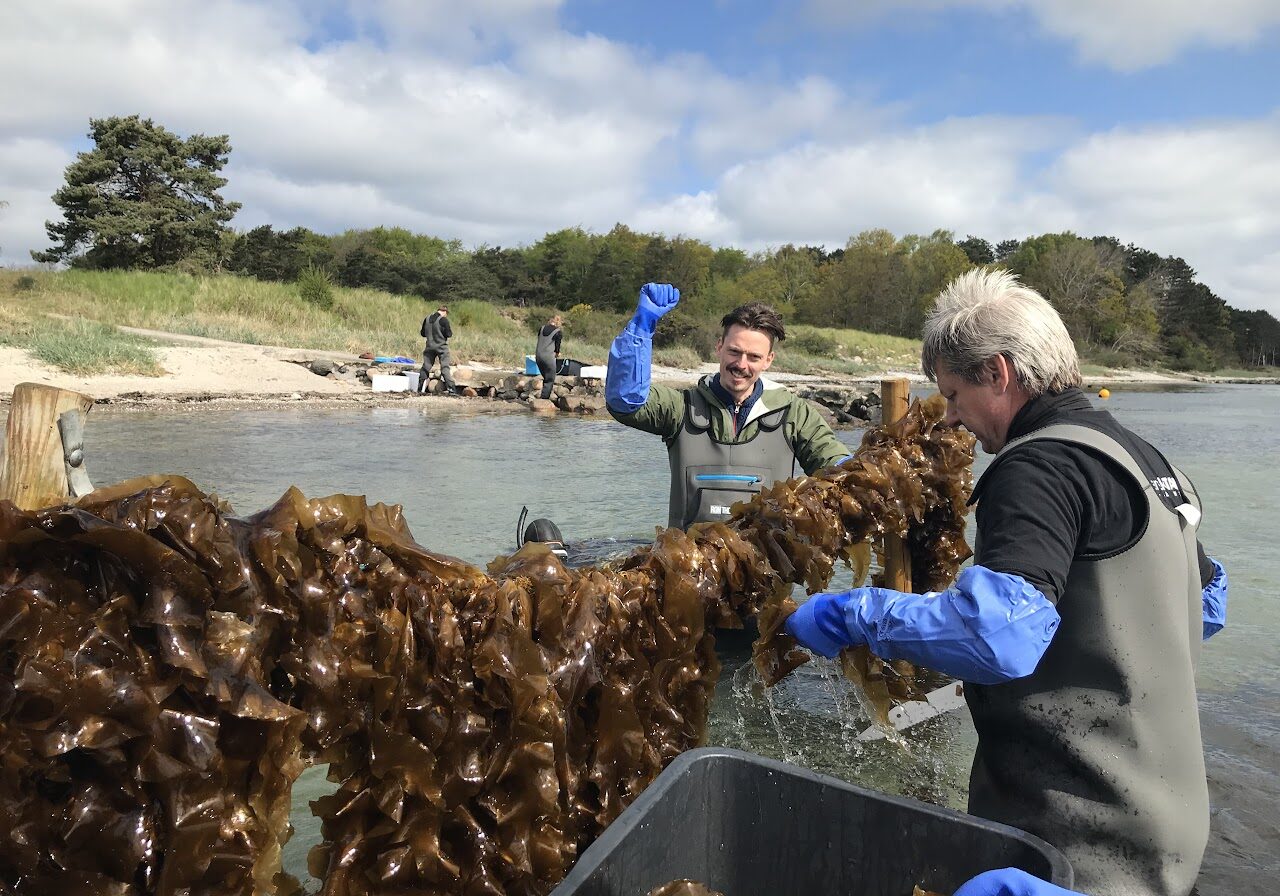Eutrofeerumine ja ökosüsteemi koormus
Elupaiku taastav merevesiviljelus on kasulik esmajoones seetõttu, et meie ookeane ja meresid ähvardavad inimtegevuse tõttu tõsised ohud. Üks suuremaid neist on eutrofeerumine rannikualadel.
Eutrofeerumine tekib liigsuurest toitainete (peamiselt lämmastiku ja fosfori) voost veekogudesse, mis omakorda põhjustab vetikate ja taimede vohamist. Liigsed toitained pärinevad sageli põllumajandusest, reoveest ja tööstussaastest. Kuigi toitained on taimekasvuks vajalikud, võib nende üleküllus tuua kaasa suuri keskkonna- ja majandusprobleeme. Veekogud eutrofeeruvad neljas etapis.
- Toitainetega rikastumine: üleliigne toitainete sattumine veekogusse suurendab lämmastiku- ja fosforivoogu.
- Vee õitsemine: liigsed toitained soodustavad mikro- ja makrovetikate vohamist, mis paneb veekogu õitsema.
- Decomposition: vetikate elutsükli lõppedes vajuvad need põhja, kus bakterid hakkavad neid lagundama. See protsess vajab hapnikku, mis omakorda põhjustab vee hapnikutaseme alanemise.
- Hüpoksia ja anoksia: väga suur hapnikutarve veekogu põhjas võib vähendada hapnikusisaldust sellisel määral, et vee-elustik ei suuda seda enam taluda.
Euroopa rannikukogukondade jaoks on meri olnud inimeste põhivajaduste rahuldaja. Kuid eutrofeerumise, kliimamuutuste, ülepüügi, merede hapestumise ja muude keskkonnariskide tõttu oleme inimkonnana sunnitud muutma oma suhtumist merevarude tarvitamisse ja võtma kasutusele taastamispõhimõtted.
Elupaiku taastav merevesiviljeluskasvandus rajatakse tavaliselt vertikaalmeetodil, mis võimaldab ruumi maksimaalselt ära kasutada ja soodustab mitme liigi kooskasvatamist.
Vesiviljeluskasvanduse tehnilised lahendused
Elupaiku taastav merevesiviljeluskasvandus rajatakse tavaliselt vertikaalmeetodil, mis võimaldab ruumi maksimaalselt ära kasutada ja soodustab mitme liigi kooskasvatamist. Kasvandus koosneb merepõhja kinnitatud püstliinidest, mis on ühendatud pinnal hõljuvate poidega. Püstliinide vahele on veesambasse riputatud põikköied või -võrgud, mis moodustavad võrestikusarnase struktuuri. Rasked ankrud merepõhjas hoiavad kogu süsteemi paigal, samas kui pinnal olevad poid hoiavad liinid pingul ja toetavad kasvavate organismide raskust.
Kasvandust saab kasutada järgmistel eesmärkidel:
Merevetikate kasvatamine
Merevetikaid kasvatatakse veesambas rippuvatel põikköitel või võrkudel. Erinevaid vetikaliike saab kasvatada erinevatel sügavustel vastavalt nende valguse- ja toitainetevajadustele.
Karpide kasvatamine
Rannakarpe, austreid ja kammkarpe kasvatatakse võrkpuurides või liinidel, mis on kinnitatud konstruktsiooni külge. Karbid filtreerivad vett, parandades selle kvaliteeti ja toetades ümbritseva merekeskkonna heaolu.
Multitroofne ehk hulgitoiteline kasvatus
Eri liiki merevetikate, karpide jm kooskasvatamisel tekib kasvanduses tasakaalustatud ökosüsteem, mis suurendab elurikkust ning parandab kultiveeritavate organismide vastupidavust kahjuritele ja haigustele.

kasvandustes kasutatakse üha enam andureid keskkonnatingimuste (näiteks veetemperatuuri, soolsuse ja toitainesisalduse) jälgimiseks, et optimeerida kultiveeritavate liikide kasvuolusid.
Elupaiku taastav merevesiviljeluskasvandus rajatakse tavaliselt järgmistes etappides.
- Ankurdamine: Stabiilsuse tagamiseks paigaldatakse merepõhja rasked ankrud. Nendeks võivad olla betoonplokid, metallankrud või kivid.
- Püstliinid: Ankrute külge kinnitatakse tugevad köied või trossid, mis omakorda ühendatakse pinnal olevate poide külge. Püstliinid moodustavad kasvanduse n-ö tugitalad.
- Põikköied või võrgud: Püstliinide vahele paigutatakse eri sügavusel põikköied või võrgud, nii et veesambas moodustub võrestik. Merepõhjas olevad rasked ankrud hoiavad seda kindlalt paigal. Võrestik pakub merevetikatele ja karpidele soodsat kasvupinda. Vahel kinnitatakse köite või võrkude külge ka karbikasvatuse puurid.
- Kasvatamine: Liinidele kinnitunud vetikate noorjärgud mähitakse põikköite ümber. Karbid paigutatakse võrkkottidesse või -puuridesse, mis ripuvad konstruktsiooni küljes. Mõnikord kinnituvad merekarbid ise põikköitele või võrkudele.
- Poid ja ujuvplatvormidpinnal olevad poid hoiavad köied pinge all ja tagavad selle, et kasvuliinid püsivad kindlas sügavusvahemikus. Mõnes kasvanduses kasutatakse lisaks ujuvplatvorme, mis lihtsustavad ligipääsu ja aitavad kasvandust paremini hooldada. Platvormil võib hoida ka koristus-, seire- ja hooldusseadmeid.
Kasvandust tuleb korrapäraselt hooldada, et tagada selle optimaalne toimimine. Hooldus hõlmab konstruktsiooniosade ülevaatust ja kahjustatud osade väljavahetamist.
Elupaiku taastav merevesiviljeluskasvandus on kavandatud nii, et see oleks tõhus, vastupidav ja keskkonnahoidlik. See aitab parandada mere ökosüsteemide seisundit ja toota väärtuslikku toitu.
Viljeldavad kultuurid
Elupaiku taastava merevesiviljeluskasvanduse peamised kultuurid on merevetikad ja -karbid, mis parandavad keskkonnatingimusi ja toovad samal ajal ka majanduslikku kasu.

Pruunvetikad
Maailmas kasvatatakse väga palju pruunvetikaid, kuid tuntumad neist on suhkru-lehtadru (Saccharina latissima, astuuria keeles kombu) ja söödav alaaria (Alaria esculenta). Pruunvetikaid kasvatatakse tavaliselt veesambasse riputatavatel püstliinidel või võrkudel. Neid kasutatakse toiduainetes, kosmeetikatoodetes, väetistes, loomasöödas ja biokütustes. Pruunvetikad sisaldavad palju vitamiine ja mineraalaineid, mis teeb nendest väärtusliku toidulisandi. Eesti rannikumere soolsus on paraku liiga väike, mistõttu enamik vesiviljeluseks sobivaid pruunvetikaid siin ei kasva. Üheks võimalikuks kandidaadiks võib siiski pidada meie kohalikku liiki põisadrut (Fucus vesiculosus).
Punavetikad
Olulisemad kultiveeritavad punavetikaliigid on kämmalpalmaaria (Palmaria palmata, dulse), porfüüra (Porphyra, nori) ja karrageenivetikas (Chondrus crispus). Sarnaselt pruunvetikatega kasvatatakse ka punavetikaid köitel või võrkudel, kuid nad asetatakse neile sobivate valgustingimuste saavutamiseks pruunvetikatest sügavamale. Punavetikaid kasutatakse toidus, karrageeni (paksendusaine) tootmisel, kosmeetikatoodetes ja ravimites. Eesti rannikumeres võiks viljeleda agarikku (Furcellaria lumbricalis), kuid seni pole selle liigi jaoks sobivat kasvatustehnoloogiat välja töötatud.
Rohevetikad
Vesiviljeluses levinumad rohevetikaliigid on salat-ulva (Ulva lactuca) ja Codium fragile. Kuna rohevetikate valgustarve on väga suur, sobib neile kasvuks pindmine veekiht. Neid kasutatakse salatites, suppides ja muus toidus. Samuti on rohevetikatel suur potentsiaal biokütuste tootmisel ja loomasööda lisandina. Eestis on võimalik samuti rohevetikaid kasvatada ning selleks sobivad kõige paremini harilik soolikvetikas (Ulva intestinalis) ja U. linza.

Söödav rannakarp
Söödavat rannakarpi (Mytilus edulis) kasvatatakse tavaliselt veesambas rippuvatel püstköitel või võrkudel. Karbid filtreerivad palju vett, eemaldades seeläbi veesambast tahkeid osakesi ja parandades vee kvaliteeti. Samuti kiirendavad nad toitainete ringlust ja pakuvad elupaiku teistele mereorganismidele. Valgurikkad ja rohkesti oomega-3-rasvhappeid sisaldavad karbid on populaarsed mereannid. Eestis kasvab looduslikult söödava rannakarbi hübriid (Mytilus edulis ja M. trossulus) ning mujal kasutatud kasvatusmeetodid sobivad ka meie rannikumerre.
Austrid
Kuna suurt hiidaustrit (Crassostrea gigas) peetakse mõnes Euroopa veekogus invasiivseks liigiks, kasvatatakse seda tavaliselt triploidsena, et vältida paljunemist. Austreid kultiveeritakse võrkpuurides, salvedes või veesambas olevatel köiejadadel ning neid hinnatakse kõrgelt nende kulinaarse kasutuse tõttu. Nad sisaldavad palju tsinki ja B12-vitamiini. Eestis austrid ei kasva, kuna siinse merevee soolsus on liiga väike.


